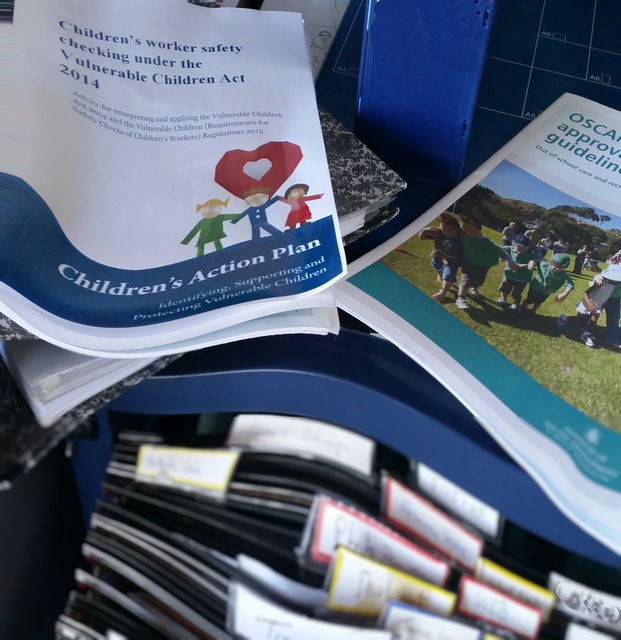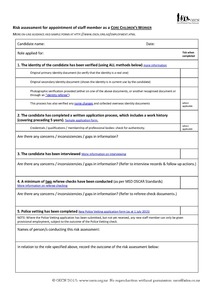Staff safety checking
Overview of requirements under the Children's Act 2014
“The responsibility to take all reasonable care in making an appointment lies with you and your organisation.”
“Safer Recruitment Safer Children” Child Matters / Children’s Action Plan
The Children's Act (2014) (which was called the Vulnerable Children Act) brings into force comprehensive child protection requirements for the whole children services sector. For OSCAR services, many of the requirements are consistent with what is already in place under the Accreditation Standards for OSCAR. We have explained some of the key terminology and background to the Act elsewhere. Refer to background information on the Children's Act here.
- As an introduction to the screening and vetting process please refer to our staff risk assessment form and related links that explain identity checking, interviewing and referee / background checking.
- In general, we recommend that all providers review their current polices for child protection and staff recruitment. We have a fully revised Child Protection policy at our resources archive. We also suggest updating your policies to reflect the new legislation: e.g. “Our programme will operate in accordance with the requirements of the Children's Act (2014)”
A note on advertising: even before the screening process starts, your organisation can send a clear message about child safety and child protection to potential applicants, and to the general community.
- “This job has a high level of child contact.”
- "Our organisation takes its child safety and child protection responsibilities seriously."
- "Our staff recruitment is carried out in accordance with the the Vulnerable Children Act."
- “This is the process we will use to screen all applicants.”
These sorts of messages will help deter inappropriate people from applying and also help prepare candidates for screening, which can be a sensitive and sometimes a challenging process.
Important requirements
The following guidance incorporates many familiar OSCAR Accreditation requirements, but with some new terminology.
Some significant new areas that OSCAR services should be aware of:
- The Act introduces new terminology such as “core worker” and “workforce restriction”.
- There is a much stronger focus on identity verification, as well as promoting rigorous practices for interviewing and referee checking.
- There is equal emphasis on the entire range of background checking processes; it is not sufficient to be satisfied (from a child protection viewpoint) with just a clean police vetting result.
- Keeping sufficient documentation of each stage of the safety checking process is important to show compliance with the Act.
- A wider range of offences are specified (when compared to previous versions of the OSCAR Standards), that restrict who may be employed (unless an exemption for that person is obtained). View a list of the specified offences
- Periodic re-checking of all existing staff is required to be carried out as a minimum every three years.
- The guidelines provided for the Act confirms that it is appropriate that all vetting and screening information should retained “where required for audit purposes.” This would include OSCAR services retaining copies of all police vetting results, so that Te Kahui Kāhu Accreditation Assessors can view them.
- As of July 1st 2015 the form used to apply for police vetting has been changed to incorporate new requirements. Police vetting forms link. According the guidelines provided by the Government agencies responsible, police vetting results clearly highlight any information about specified offences under the Act, where the workplace restriction will apply (i.e. for a core worker).
- Self-employed people: official guidance has acknowledged that there are limitations on safety checks for self-employed people (e.g. OSCAR owner/operators).
Risk assessment form
The end point of the safety checking process is a risk assessment of the candidate’s suitability to take on a children’s worker role in your organisation. The Risk Assessment Checklist is a suggested format for this process and covers each stage of the safety check.
Guidelines re- volunteers
For police vetting purposes, volunteers are treated as “non core workers.” Suitable safety checks still need to be applied and steps taken within the organisation to manage the risk, subject to the practical restraints on the degree of screening that can be carried out for volunteers. Meaning, that it is sometimes impractical and a potential barrier to recruiting volunteers if there is a high level of screening being carried out.
Volunteers are not subject to Children's Act requirements but suitable safety checks still need to be applied and steps taken within the organisation to manage the risk as part of requirements for OSCAR Accreditation. It is sometimes seen as impractical and a potential barrier to recruiting volunteers if there is a high level of screening being carried out. However, this can make voluntary positions especially attractive to people who may want less scrutiny of their backgrounds.
As a minimum there should be identity verification and some background information provided about previous roles with children (that could be checked as necessary). You may also conduct an interview where motivation and attitude to children can be discussed. Alternatively, use a group interview/training process where attitudes and behaviour can be observed.
“People who have been only partially screened should not be put in charge of children of work alone with children.”
“Good supervision [by properly screened, trusted core staff can significantly reduce risk by limiting opportunities for inappropriate conduct.”
(“Safer Recruitment” Children Matters http://www.childmatters.org.nz/file/Resources-page/safer-recruitment-safer-children-fa-2.pdf)

